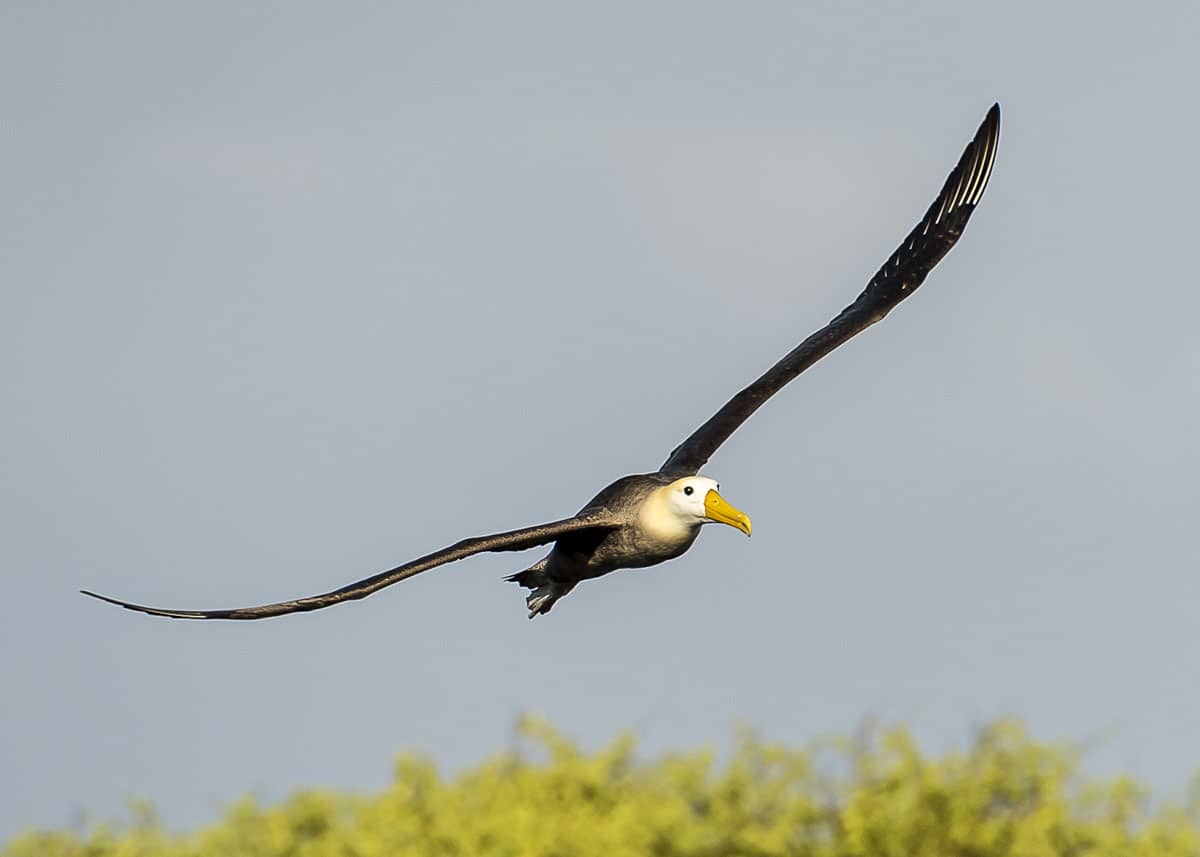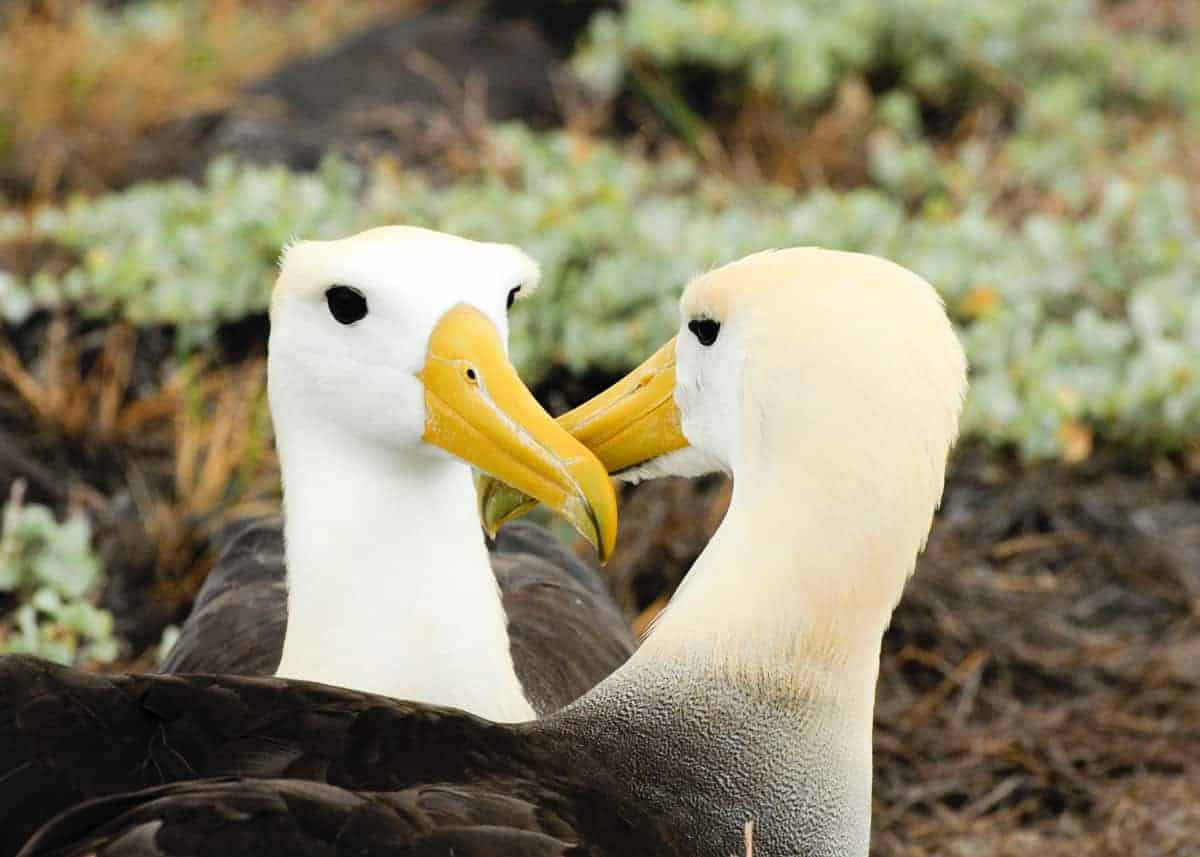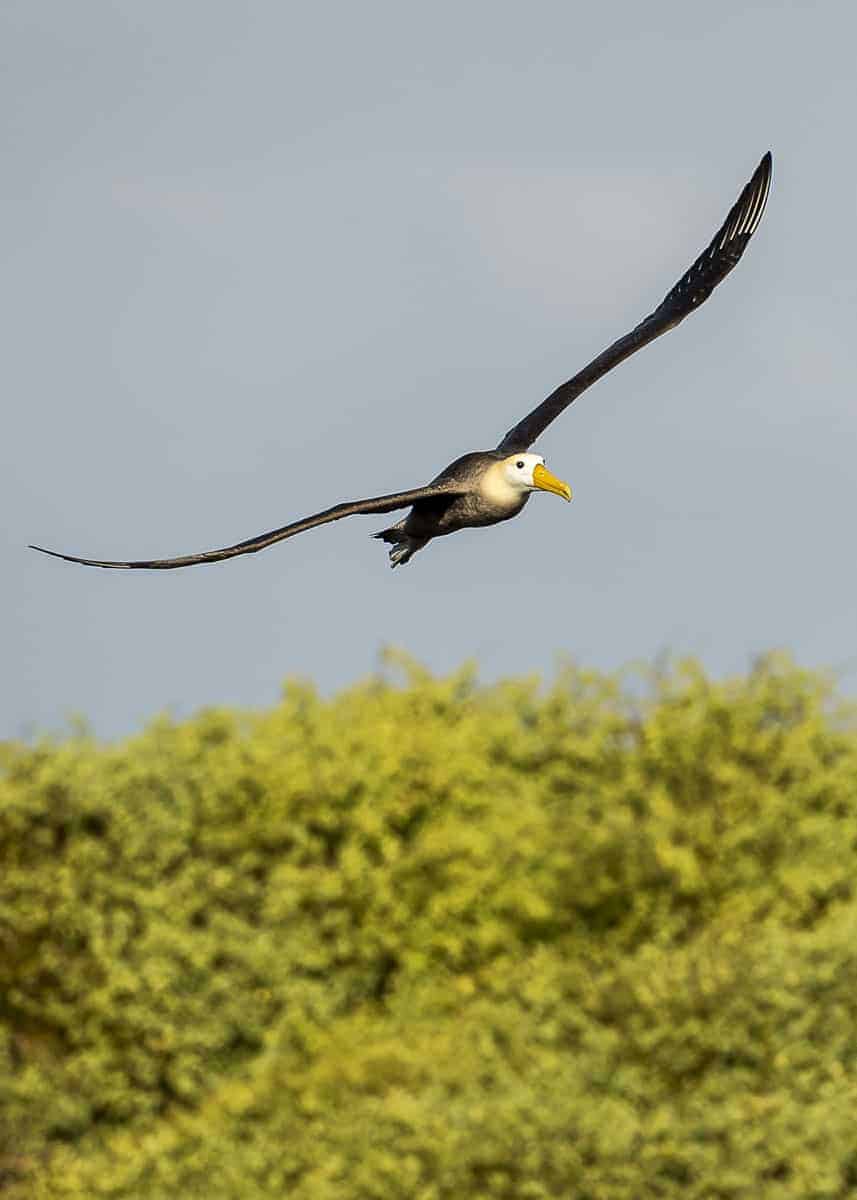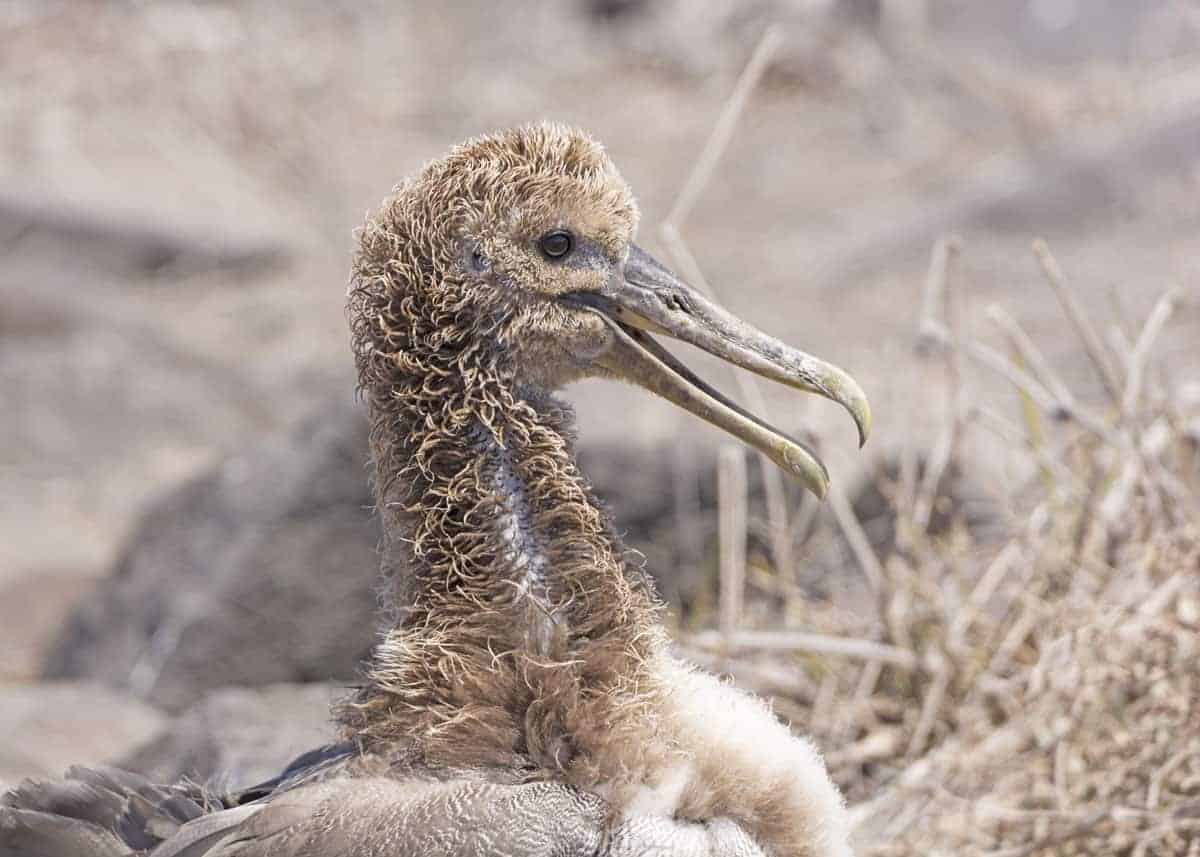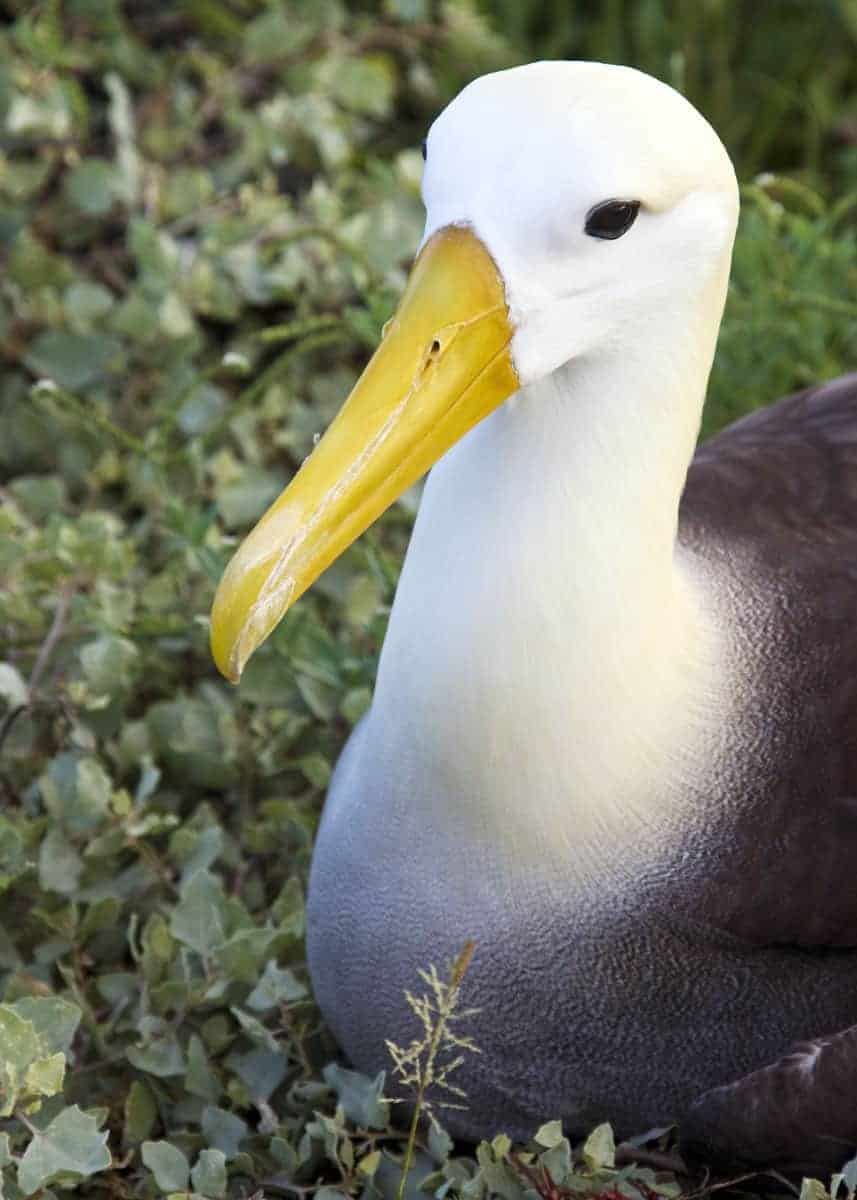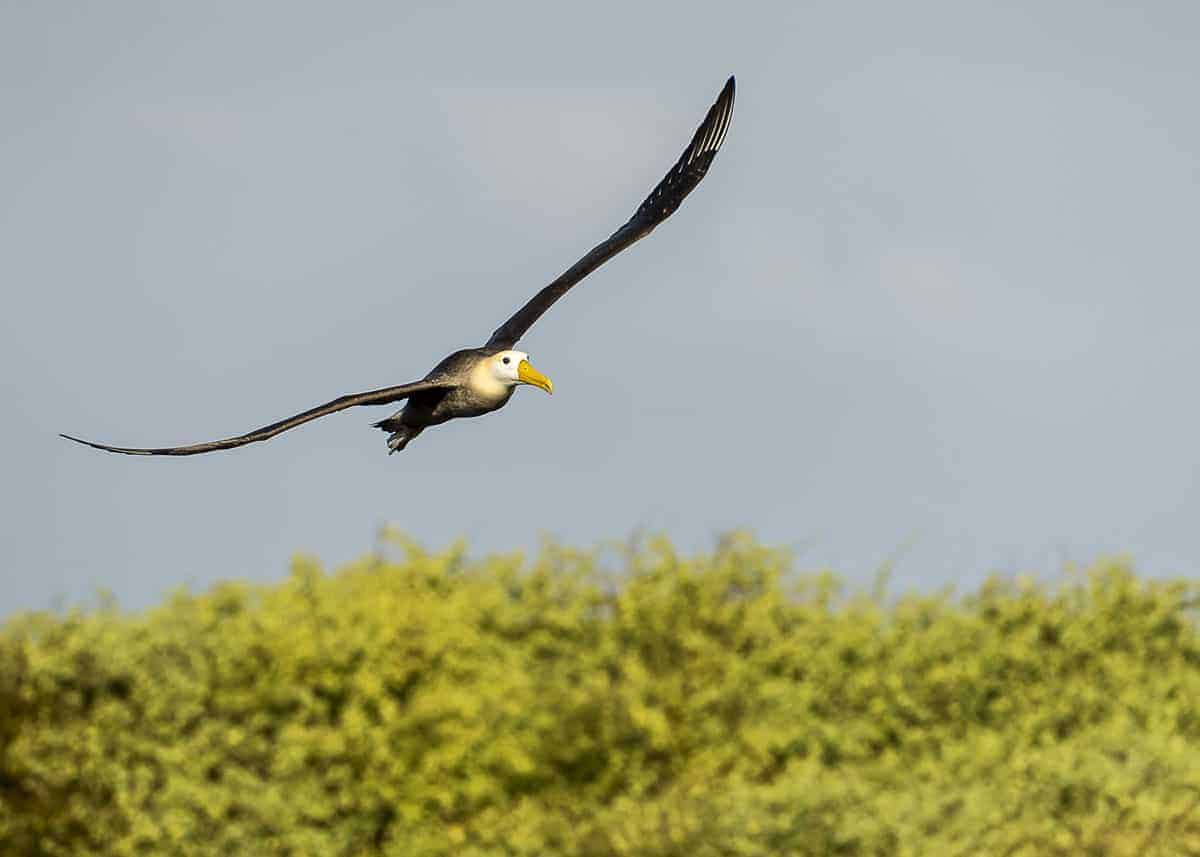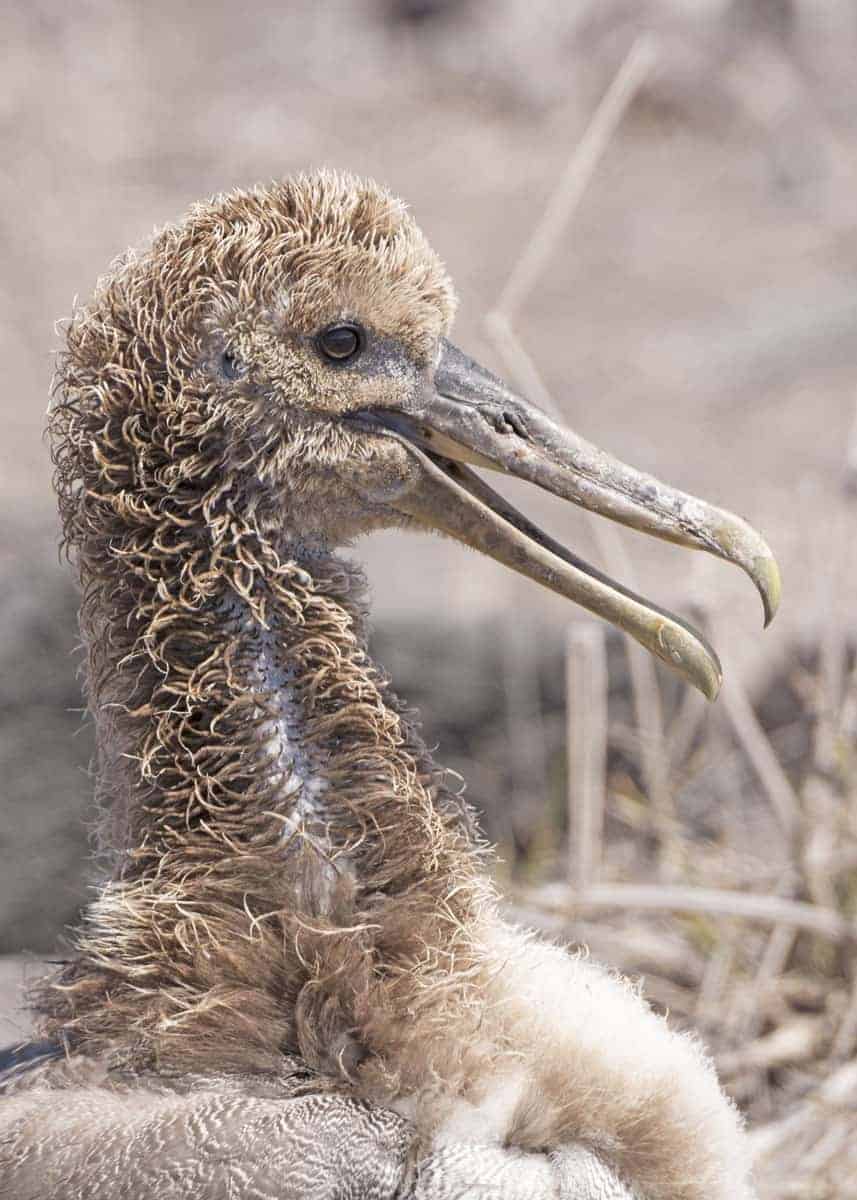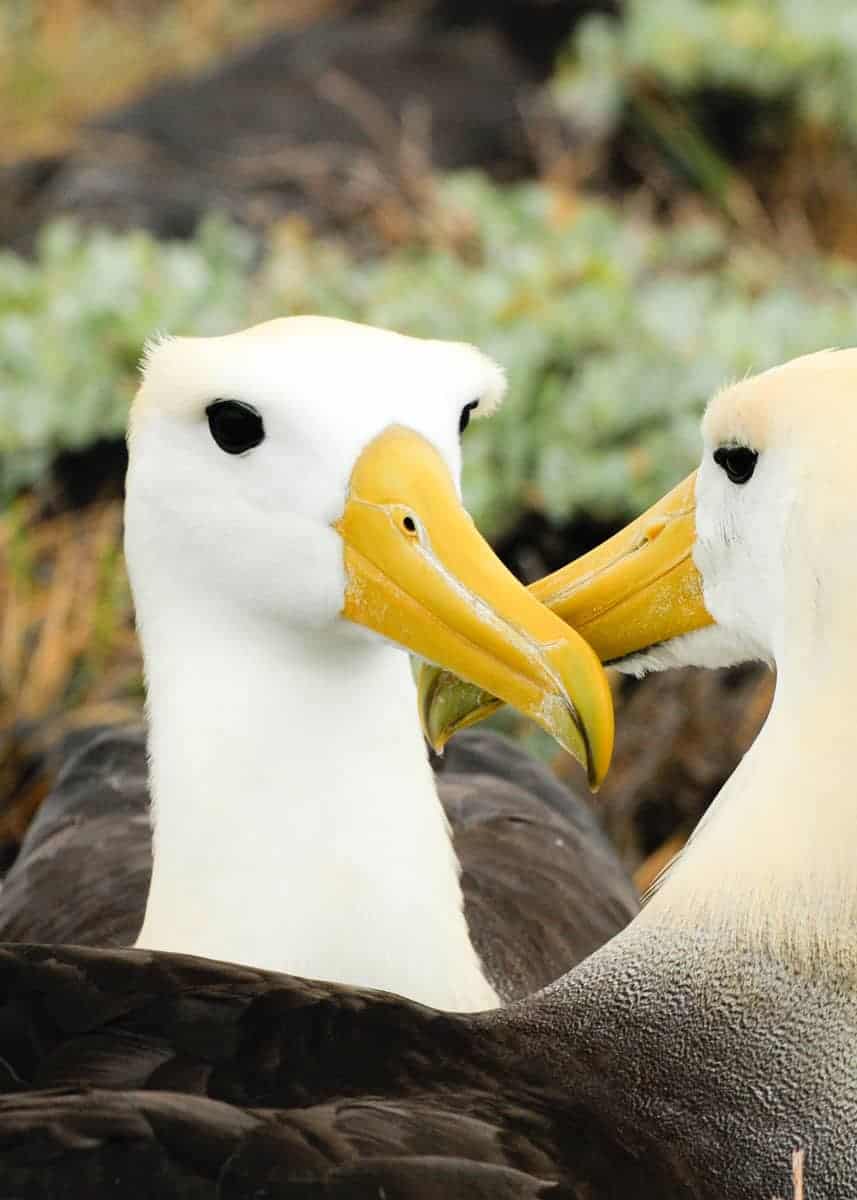25 Waved Albatross Facts: Largest Galapagos Bird (It has 8ft Wingspan!)
The waved albatross is the largest bird in the Galapagos Islands. In this post, you’ll learn 25 facts about the waved albatross, including diet, wingspan, mating habits (including a special mating dance), range and more. Plus lots of photos and videos.
Travel tip: If you’re traveling to the Galapagos, you should bring a camera with a good zoom and a decent pair of binoculars. This will increase the odds of spotting and shooting a waved albatross in the wild.
Guide to the Waved Albatross
They’re often admired for their life-long mating habits, and their elaborate courtship dance has been featured in videos that have gone viral.
But, did you know that the waved albatross is also the largest bird in the Galapagos Islands? Or, did you know that it has a wingspan that’s wider than the height of NBA player, LeBron James?
Keep reading to learn 25 interesting waved albatross facts.
Did you know? The waved albatross is also known as the Galapagos albatross.
Waved Albatross Overview
- Latin Name: Phoebastria irrorata
- Range: Galapagos Islands and the coasts of Ecuador, Peru, Colombia, and Chile. There is a small population (less than 20 breeding pairs) on Isla de la Plata, just off Ecuador’s coast.
- Population Status: Between 50,000 and 70,000 individuals (12,000 breeding pairs)
- Size: Height: 31 to 35 inches (80 to 90 cm); Weight: 6 to 8 pounds (2.7 to 4 kg)
- Spanish name: Albatros de Galápagos (Galapagos Albatross)
- Wingspan: 7.2 to 8.2 feet (2.2 to 2.5 m)
- Diet: Fish, squid, shrimps, crabs, krill, lobsters, and other crustaceans
- Notable Feature: Famous courtship ritual
- Where it lives in Ecuador/Galapagos: Española Island
25 Waved Albatross Facts
1. Where does the waved albatross live?
The waved albatross enjoys life at sea, but during the breeding period, it makes its home on the island of Española in the Galapagos Islands.
Two colonies on Española Island make up the waved albatross’ estimated population of 70,000 individuals.
However, about 10 or 20 breeding pairs have also been sighted on Genovesa Island in the Galapagos archipelago as well as on Isla de la Plata, which is off the coast of Ecuador.
Between January and March when the waved albatrosses aren’t breeding, they fly out to sea, congregating on the waters along the coasts of Colombia, Ecuador, Peru and Chile.
2. Where can you see albatross in the Galapagos?
The waved albatross is the only albatross species in the Galapagos Islands, and the best place to see them is on Espanola Island. You could possibly see a few breeding pairs on Genovesa Island.
3. What is the habitat of the waved albatross?
The open sea is the waved albatross’s first love, but during its time on land, it favors rocky areas such as cliff tops and lava ledges with little vegetation.
Even then, the waved albatross prefers its land habitat nearby the sea so that it doesn’t have far to go for food.
4. Where do waved albatross nest?
Waved albatrosses nest on the ground, lava flows, or rocky ledges where there is sparse vegetation to prevent their eggs or chicks from becoming entangled in thick grass.
Like other albatrosses, waved albatrosses don’t actually build a nest. The females simply lay their eggs in a designated area.
Afterward, both parents of each breeding pair take turns incubating their egg and rolling it from time to time over great distances, sometimes more than 100 feet (30 m).
It’s believed that they roll their eggs to encourage successful hatching.
5. What does the waved albatross look like?
- As the largest bird in the Galapagos Islands, the waved albatross is easily recognized by its size, long yellow hooked bill, short legs, and bluish webbed feet.
- These physical features make the waved albatross appear clumsy and comical when it walks and communicates with one another. But, its wide wingspan enables it to fly effortlessly with little wing-flapping.
- Both sexes also feature pale yellow heads and necks with chestnut-brown upperparts and a white breast.
- Juveniles appear similar to their parents except that their heads are more white.
6. How tall is the waved albatross?
An adult waved albatross grows between 31 and 35 inches (80 and 90 cm) in height.
7. How much does a waved albatross weigh?
A waved albatross can weigh anywhere from 7 to 11 pounds (3 to 5 kg). Males are usually heavier than females.
8. What is the waved albatross wingspan?
The waved albatross has an impressive wingspan. It measures between 7.2 and 8.2 feet (220 and 250 cm).
That’s wider than the height of most professional basketball players.
9. What bird has the longest wingspan?
An albatross boasts the longest wingspan, but it’s not the waved albatross. It’s the wandering albatross, which has a wingspan that can reach nearly 12 feet (4 m).
10. How did the waved albatross get its name?
The most popular theory about how the waved albatross got its name is from the wave-like pattern on its feathers.
But, the bird may also get its name from how it glides over the ocean waves for long periods of time.
11. Are waved albatross friendly or aggressive?
Waved albatrosses are sometimes aggressive toward one another when defending their territory. They’re also known to steal food from the mouths of other birds. Humans may see this as aggressive, but to the waved albatrosses, it’s just survival.
Waved albatrosses aren’t known to be aggressive toward people. Like most of the birds and animals on the Galapagos Islands, they are not afraid of humans.
Many tourists visit Española Island by cruise ship to see the waved albatrosses in person and are able to get fairly close to the birds to observe them practicing their courtship rituals.
12. How long do waved albatross live?
Waved albatrosses can live up to 45 years.
In the bird world, albatrosses are known to have long lifespans. The oldest living albatross recorded is a Laysan albatross from Hawaii, which is around 68 years old.
13. What eats a waved albatross? Predators and Threats
The largest threats to the waved albatross are human-related and include water pollution, chemicals, marine plastic pollution, oil slicks, disturbance from tourism, and overfishing which reduces the bird’s food supply.
But, the greatest threat to the waved albatross population is long-line fishing because the birds are naturally attracted to the bait on the lines.
When the albatrosses try to grab the bait, they get hooked, dragged under, and drown.
Long-line fishing is illegal on the Galapagos Marine Reserve, but outside that area, the birds aren’t protected.
Other threats include disease, swarms of mosquitoes, and severe weather which affects food sources.
14. Are waved albatross extinct?
If you’ve read down to this question, then you know that waved albatrosses are not extinct. Read on to learn about their current conservation status.
15. Is the waved albatross endangered?
Yes. According to waved albatross facts listed by the International Union for the Conservation of Nature (IUCN), this albatross is classified as Critically Endangered (CR).
16. What does the waved albatross eat?
Waved albatrosses love seafood such as fish, squid, shrimps, crabs, krill, lobsters, and other crustaceans.
At night, they head far out to sea and hunt for prey that swims close to the surface.
They’ve also been known to steal food from other birds such as fish and even regurgitated food.
17. What is the waved albatross Latin name?
- Class: Aves
- Order: Procellariiformes
- Family: Diomedeidae
- Genus: Phoebastria
- Species: Phoebastria irrorata
18. Do waved albatross mate for life?
Along with other albatrosses, waved albatrosses do mate for life. They form monogamous pairs that last until one of the pair dies.
Even after flying thousands of miles for long periods of time, they always come back to their breeding site to mate with their life partner and raise chicks together.
Learn more about other animals that mate for life.
Waved Albatross Mating Dance
19. At what age do waved albatross lay eggs?
On average, waved albatrosses begin laying eggs around five years of age when they become sexually mature.
However, some may begin laying eggs as early as three years of age.
20. How often do waved albatross lay eggs?
Waved albatrosses usually lay their eggs once a year between April and June.
If an egg doesn’t successfully hatch or something happens to the chick, a breeding pair might lay another egg.
21. How many eggs does the waved albatross lay?
The waved albatross lays a single white egg per breeding period between April and June. The parents take turns incubating it for two months until it hatches.
A few weeks after it hatches, the brownish-black chick is left in a “nursery” while the parents fly out to sea for food.
The prey that the parents catch is not digested but kept inside their stomachs where it turns into an oily chick formula. When the parents return to land, they pump this formula into their chick.
They can feed their chick up to 4.4 lb (2 kg) of oil in one feeding.
22. What is the waved albatross call? Are they loud?
These sea birds vocalize a variety of sounds that include whistling, bill clacking, honking, and low moo-like calls.
They are especially noisy during their courtship ritual when they clap their bills loudly and speak a language of love through honking sounds that are accompanied by head-bobbing and bowing.
23. Do waved albatross carry disease?
A few waved albatrosses have been infected with avipoxvirus, a bird virus that causes wart-like growths and pock lesions around the eyes and other non-feathered areas.
If not treated, this disease can lead to blindness, stunted growth, and reduced egg production.
Waved albatrosses are also at risk for developing problems caused by lice and parasites as well as salmonella and avian malaria.
Fortunately, there are conservation teams that monitor and prevent the spread of disease affecting all of the birds on the Galapagos Islands.
24. Where can I see the waved albatross?
From January to March, waved albatrosses are out to sea, so if you want to see them in person, you’ll need to visit Española Island in the Galapagos Islands between April and December.
A popular way to see waved albatrosses is by taking a Galapagos Island cruise.
After a stop on Española Island, you can go on a hiking or kayaking tour that offers the amazing experience of seeing these albatrosses perform their famous courtship dance.
25. What is the purpose of the dancing that the albatross does?
Many birds practice a courtship ritual to attract a mate, but none are as spectacular as that of the waved albatross.
The courtship dance of the waved albatross looks like a perfectly choreographed dance routine that involves bill-fencing, head-bobbing, bill-clacking, and bowing with honks and moo-like calls.
The courtship dances of waved albatrosses can be seen on Española Island anywhere from April to October, but the dances of the newly-established pairs are the most elaborate and occur in October.
Learn more about other Galapagos Island animals.
Your Turn
By now, you know that the waved albatross is an extraordinary bird with many cool features.
What did you think about these 25 waved albatross facts? Were you surprised by any of them? Have you ever seen the waved albatross in person? Let us know in the comments.

